Life On ‘Mars’: Ewing Leads Aggie Team In Iceland, Conducting Research For NASA
Dr. Ryan Ewing, two Texas A&M students and one postdoctoral researcher conducted research for three weeks on Mars-like terrain in Iceland to test rover technology for NASA’s Mars 2020 mission and to study how the planet evolved over time.
Nov 26, 2019
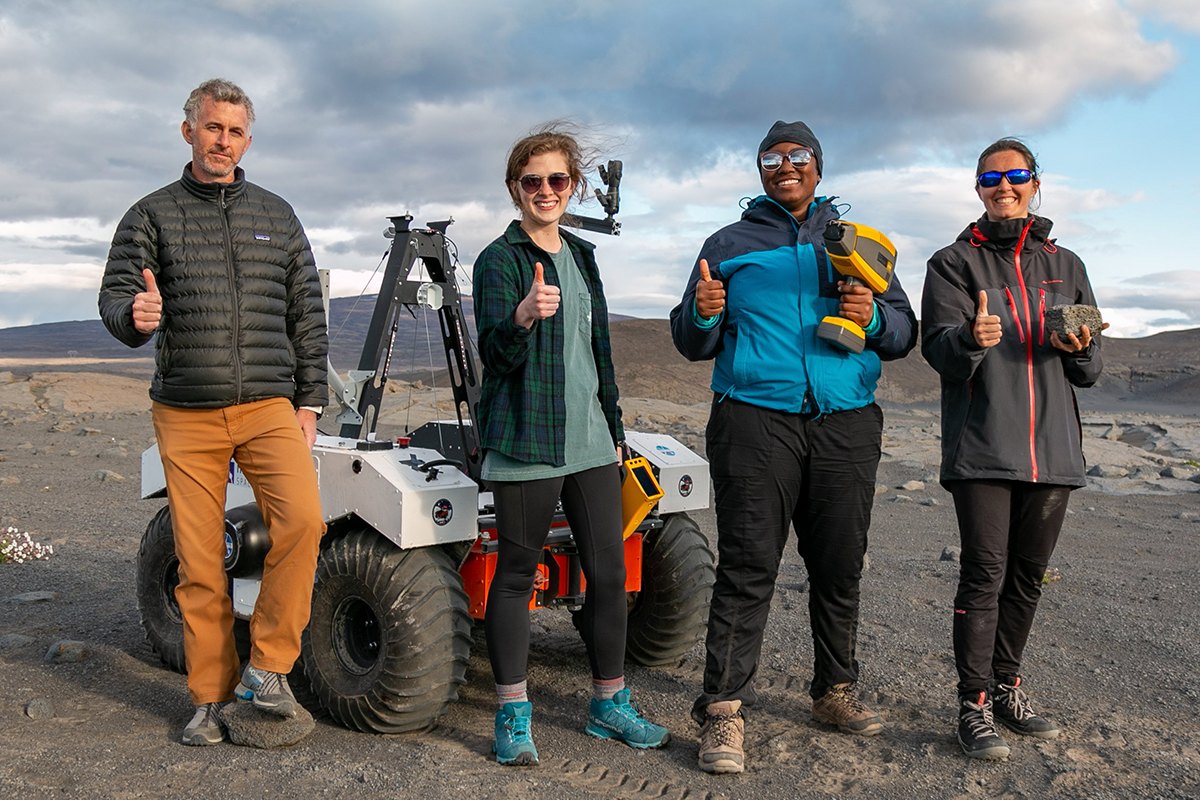
Most people don’t choose to work in extreme environments.
A lifeless, gray, rocky terrain with mountains and plains that stretch for miles on end – interrupted only by the occasional shrub or trace of a long-dead river – this part of Iceland is about as desolate and brutal as nature can get.
But Dr. Ryan Ewing isn’t most people.
To Ewing, a professor in the Department of Geology and Geophysics in the College of Geosciences at Texas A&M University and principal investigator for the Aeolian Lab, rural Iceland is one of the best proxies humans have on Earth to study Mars, making it one of the most intriguing and exciting places on Earth.
“Studying Mars could unlock what Earth was like when life just began and if life existed elsewhere,” Ewing said.
For three weeks this summer, Ewing led a team of scientists, engineers and students to this patch of Mars-on-Earth for a research project funded by a $1.1 million NASA grant.
Scientifically, their task was to study the Mars-like terrains in order to learn more about how the Red Planet’s sediments change physically and chemically. Operationally, they tested the capability of artificial intelligence and drones for rover science operations and navigation for NASA ahead of its Mars 2020 mission.
“It is very exciting to know the data we’re collecting here will be used by the 2020 team when they land on the surface of Mars,” Ewing said by phone in July from his team’s base camp in Iceland. “When you perform this operation, you’re working with complex robotics and science questions in extreme environments, so you have be sure the decisions are efficient.”
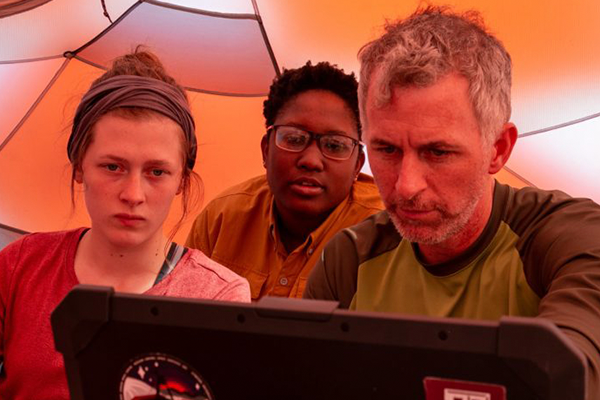
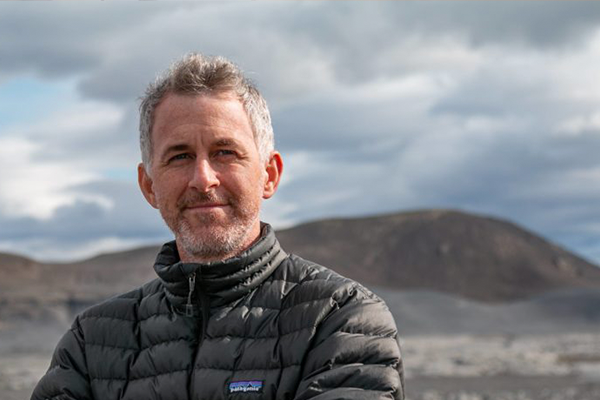
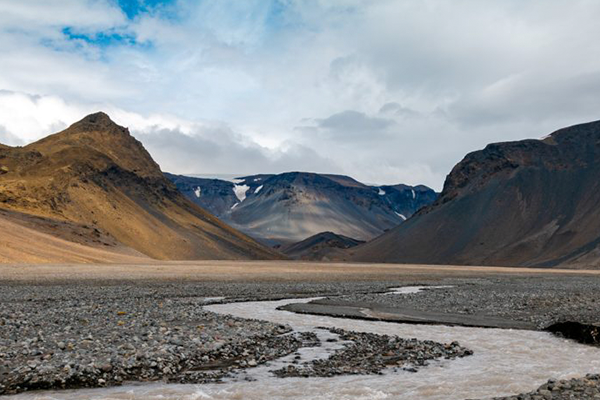
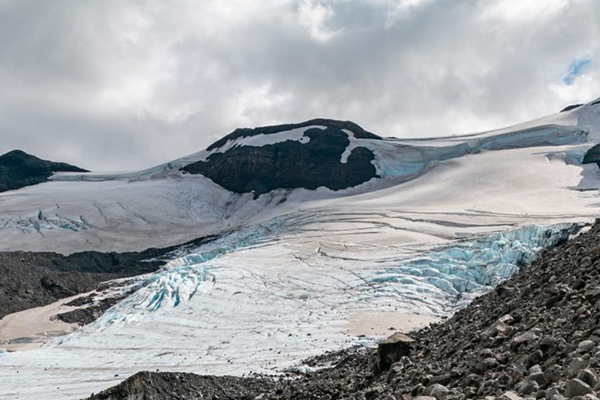
From Curiosity to 2020
Ewing’s interest in the intersection of science and operations for missions on Mars began with his work on the Mars Curiosity rover, where he studied the planet’s terrain and provided geological information to NASA’s engineers who would determine where the rover went. During that time, he saw the opportunity to use artificial intelligence to inform how robots navigated the terrain.
“There was interest at the time with using A.I. to understand natural terrains,” he said. “We realized the architecture hadn’t been fully deployed into a mission, but that it would be on the Mars 2020 mission.”
The Mars 2020 mission plan, which calls for a July/August 2020 launch and a February 2021 landing, hopes to answer questions about the potential for life on Mars, including searching for signs of habitable conditions and microbial life in the planet’s ancient past. Despite the rusty red color of the surface of Mars and the black and dark brown of Iceland’s surface, the two geographies share have more in common than some may realize.
“The ancient environment of Mars was quite similar to Iceland,” Ewing said. “Just as in Iceland, glaciers existed on the surface of Mars in addition to river systems, sand dunes and an absence of vegetation.”
The knowledge gained by using Iceland as a proxy for Mars when testing sensors and cameras on the 2020 rover will be put to work when the rover moves between drilling locations and needs to make navigation decisions based on the terrain. For example, if a rover senses that Mars’ terrain will become sandy and difficult to drive in, it can send that information back to NASA’s operating team, who will be able to adjust the route accordingly.
While the chassis of the rover accompanying Ewing and his crew in Iceland isn’t quite waist-high, the Mars 2020 rover will be 10 feet long, nine feet wide, seven feet tall and weigh 2,314 pounds.
In order to gather knowledge for NASA on a short timeline, Ewing and his team had to brave the elements, adjust on the fly to mitigate setbacks, deal with 24-hour Icelandic summer daylight and live and work efficiently as a community in confined living spaces.
Their research was supported under NASA’s Planetary Science and Technology Through Analog Research (PSTAR) Program. The title of their project is SAND-E: Semi-Autonomous Navigation for Detrital Environments.
Living as Martians
Ewing’s team was located two hours north of Reykjavik in the Icelandic highlands near a trio of glaciers, and included 19 people representing NASA, Stanford, Purdue and Canadian space firm Mission Control. It also included one Texas A&M undergraduate student, one doctoral student and a postdoctoral associate.
Each day began at 7:30 a.m. with a 30-minute team briefing to review the previous day’s activities and plan for the long day of research ahead. Weather permitting, the team departed on an hour-long drive to the research site and spent the next eight to nine hours in the field conducting research on the terrain, testing the rover vehicles and sending data back to a tent where scientists would process it. The decisions they made, which included where to drive the rover and which samples to collect, required interactions between engineers and scientists that have potential to be automated. Removing the human element from some processes could save NASA precious time during its 2020 mission.
“The richness of the collaborative discussion was impressive,” said Texas A&M postdoctoral scholar Dr. Marion Nachon. “That was one of the things we were testing: how much do you want humans involved in this kind of decision making versus having a rover doing automatic tasks.”
After an hour’s drive back on a four-wheel drive track to camp, which Ewing described as a “small rustic hut,” the research project consumed the evening hours.
“If people aren’t cooking or cleaning, they’re processing data,” Ewing said. “It doesn’t get dark, so it’s a challenge to make people go to sleep.”
Emily Champion, a junior geology major from Carrolton, Texas, worked for Ewing her first two years at Texas A&M on a project in which she mapped sand dunes on Saturn’s moon Titan. She said that even though she was preoccupied with processing data or gathering samples, she managed to pick up a few things along the way while sharing cramped space with top-tier researchers.
“Every conversation I had taught me something new,” Champion said. “Having the privilege to work alongside all of these esteemed scientists who work for NASA and these big universities, and have a lot of knowledge about the things they research, was the most rewarding.”
Kashauna Mason, a geology doctoral student on the project, said the experience was an interesting experiment in how engineers – the team members operating the rover and collecting samples – and the scientists – the team members processing data and collecting information – interact with each other, and will help prepare them for when they return to a new location in Iceland in July 2020.
“We got a lot of different types of data from the engineers, sometimes we were overwhelmed by the amount of data we were getting from them,” Mason said. “Getting back home, I would think of how ‘we could use this a certain way or we could automate this that way,’ we could get the science out in a faster manner and change how we made decisions. That is one of the aspects I am interested in: the relationship between engineers and scientists and how we can better use the results we get from each other.”
Ewing agreed.
“Scientifically, we see a lot of opportunity to advance our knowledge about the chemistry and particles of the sandy environments,” Ewing said. “Operationally, we expect to understand a lot better how to incorporate drones and A.I. in particular. We’ve already seen so far from tests that there are advantages to both.”
Ewing and his team will stay busy in the coming months planning for their return, but the importance of their mission is motivation enough.
“Humanity is exploring space faster than ever, and the research Aggies are doing right here in Iceland is making the solar system a smaller neighborhood,” Ewing said.
By Sam Peshek, Texas A&M University Division of Marketing and Communications
Originally published on Texas A&M Today

